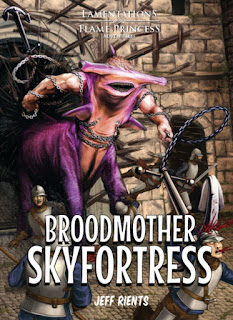Author: Jeff Rients
Publisher: Lamentations of the Flame Princess
Buy: PDF // Book + PDF Combo
TL;DR:
*Buy this if you like your fantasy à la Jack Vance weirdness and like lots of tables and GM advice.
*Do not buy this if elephant/shark combos are too weird for your boring elves & dwarves setting.
Overview:
Basically a big, floating, cloudy fortress that was created by some gods/other insanely powerful beings but is now inhabited by dumb Shark/Elephant monstaz who wreak havoc on your campaign world; they're powerful and will probably kill everyone, but why not visit anyway?
The latter half is dedicated to reproducing 'best of's from Jeff's blog. These are mainly random tables and GM advice, which in sum is solid.
Thoughts:
I had a bit of publisher credit on DrivethruRPG so I bought this because I liked the look of it and was not immune to the G+ hypemachine (though I have been strangely ambivalent lately). I've been playing a lot recently (OD&D, Warriors of the Red Planet/Numenera, Tombstone, Savage Worlds Fallout), but not writing a lot on here, mainly because I haven't been that inspired and also because I have a shit-ton of academic writing to complete; but this book forced me from my blogging-hibernation.
Serendipitously, this 'adventure' – while excellent in its own right – may be one of the very best Game Master how-to introductions on the market. It is very simply presented, is immensely user-friendly and conversational, even funny at times, and is filled with encouraging exhortations for the new Game Master. You won't find arduous theoretical pontifications on the three conceptual pillars of role-playing adventure, or platitudinous advice for 'storytellers' here. Instead, there is simple (sometimes single sentence) advice that is not only concrete but practical. This part of the work is stellar.
There are also plenty of interesting adventure options. One dubiousness I felt before reading through it was whether the shark/elephant thing was just being weird for the sake of it – as in 'hey, wouldn't it be cool if like, there were these shark-headed elephant giant dudes, and whoa, wouldn't that be super creative and original?' – and therefore a bit kitsch (not in a good way). The answer to that is 'no: it is not kitsch'. The whole conceit of the background has been well integrated and is logical albeit bizarre (in a good way). It kind of reminds me of Jack Vance weirdness. Fucking strange to the point of being comical, but weirdly makes sense. Besides, Rients offers advice to re-skin the monsters, presenting some interesting counter-ideas. By the end of it, however, I was pretty enthralled with the original premise and would definitely run it that way if I ever get the chance.
I like that it would fit pretty well with the flavour/weirdness of my OD&D campaign. The other thing I like about it is it goes beyond the rote 'this-is-how-to-run-my-adventure' thing that a lot of products do and encourages the reader to get their hands dirty and make the thing work for them. While this is not at all anomalous of OSR products generally, I find that sometimes the sparseness or ambiguity of certain products breeds equal frustration as to being overwhelmed with a wall of text: what do I do with this? Thankfully, Broodmother Skyfortress takes a very pleasing middle-ground. The prose does not get bogged down in minutia, but instead relates all the pertinent facts and even additional options, then gets out of the way. The artwork and layout cannot be faulted: I really dig it.
Conclusion:
All in all, this is one of the better adventure/supplements on the RPG market currently. Publisher James Raggi's sales blurb claims:
"Since the invention of the adventure module, there have only been five adventures that were rated the most awesome...Broodmother Sky Fortress leaves them all behind.Your game won’t suck anymore! Broodmother SkyFortress: Buying any other adventure is just throwing your money away."
Although obviously being cheeky, I don't actually think he is too far off the mark: (1) Broodmother Skyfortress is very awesome; (2) Your game will certainly improve if you use Rient's advice; (3) if we are making comparisons here, buying other adventures opens the door to the very real possibility of being disappointed – it is that good.
This is probably my first review where I don't have any critiques. What's more is that I want to run this thing immediately, pretty much as written: that is always my internal barometer of whether a product is any good. Many plant seeds of ideas, but few inspire me to follow them more or less as written: this is both due to the time it takes to digest someone else's work and the often potentiality, though not the execution, of interesting ideas that could be taken further. This adventure – let's just call it a supplement – surpasses all those caveats. Have I said it is good?




